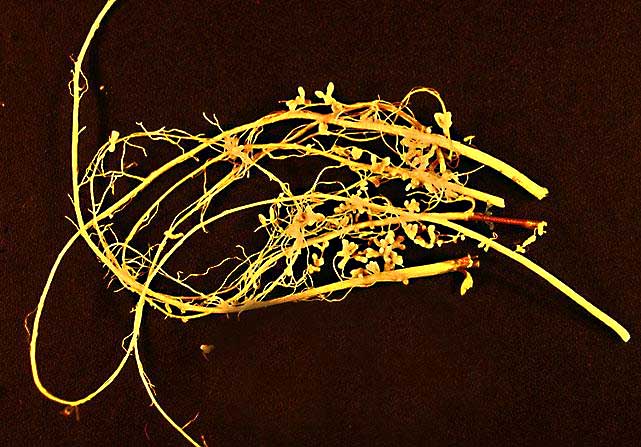Legumes, unlike most land plants, can form a root nodule symbiosis with nitrogen-fixing rhizobia. The anatomy of the nodule in legume plants was described in the 17th century, and nodule cells were found to host endosymbiotic rhizobia for nitrogen fixation in the 19th century.
The legume cortex is developmentally distinct from the cortex of non-legumes: It can de-differentiate in response to phytohormones or symbiotic signals from rhizobia, thereby enabling de novo organogenesis of nodules to accommodate nitrogen-fixing rhizobia. Nevertheless, why symbiotic nitrogen fixation is restricted to relatively few plant species, mainly in legumes, has remained unknown.
In a study published online in Nature, a research group led by Prof. Wang Ertao from CAS Center for Excellence in Molecular Plant Sciences of the Chinese Academy of Sciences found that the ancient SHORTROOT-SCARECROW (SHR-SCR) stem cell program in cortical cells of the legume Medicago truncatula specifies their distinct fate for novel nodule organogenesis.
To identify potential genetic pathway reprogramming events that underlie the cortical cell division response in legumes, the researchers generated EGFP-β-Glucuronidase reporters (promoter:EGFP-GUS) for M. truncatula and A. thaliana genes and found that the MtSCR reporter was highly expressed in M. truncatula endodermis, cortex and epidermis, which is in sharp contrast to A. thaliana AtSCR. Genetic data showed that nodule formations in scr and scr/scl23 mutants were greatly reduced and SCR expression in root cortex is required for cortical cell division during nodule initiation.
Besides, the researchers found that MtSHR1/2 mRNA expression is restricted to the stele, similar to the expression pattern of AtSHR in A. thaliana. Intriguingly, MtSHR-GUS fusion proteins accumulated GUS staining beyond the stele and endodermis, in the epidermis and cortex. Genetic data showed that cortical cell-specific accumulation of MtSHRs is required for cortical cell division during nodule initiation. Rhizobia spot inoculation and cytokinin treatment showed that cortical cell expressed MtSHR-MtSCR controls M. truncatula root cortical cells division ability.
Further studies revealed that rhizobial signals lead to the accumulation of MtSHR-MtSCR in cortical cells and nodule primordia. Ubiquitously overexpressed MtSHR in M. truncatula hairy roots promote cortical cell division and form pseudo-nodules without rhizobia inoculation. These data together demonstrate that the ancient SHR-SCR stem cell program specifies legume cortical cell fate for novel nodule organogenesis.
Recrutement of a lateral root developmental pathway into root nodule formation of legumes
More information:
Wentao Dong et al. An SHR–SCR module specifies legume cortical cell fate to enable nodulation, Nature (2020). DOI: 10.1038/s41586-020-3016-z
Provided by
Chinese Academy of Sciences
Citation:
‘Exciting biology’ reveals central event of evolution of rhizobial endosymbiosis (2020, December 10)
retrieved 10 December 2020
from https://phys.org/news/2020-12-biology-reveals-central-event-evolution.html
This document is subject to copyright. Apart from any fair dealing for the purpose of private study or research, no
part may be reproduced without the written permission. The content is provided for information purposes only.



